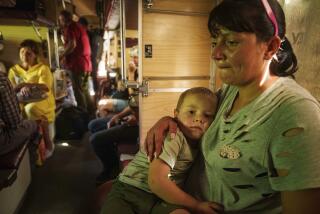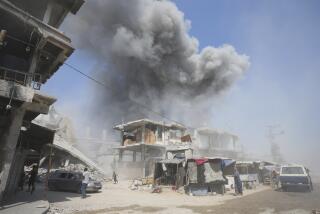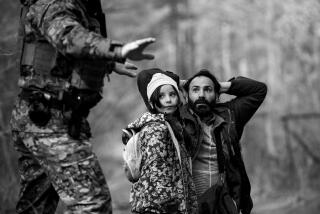On the Bosnia Front, Lines Become Blurred : Balkans: Victims, aggressors often trade roles and âhavenâ borders are unclear. U.N. troops can only watch.
RIBNICA, Bosnia-Herzegovina â When shooting starts each night at sunset on the lush, wooded hills across from 2nd Lt. Jens Karegrenâs hilltop tank unit, there is little the Nordic soldiers can do but settle in and watch the fight.
Unless the bullets, mortars and tank rounds of the Bosnian government or Serbian troops are targeted at the U.N. forces, the peacekeepers posted on a promontory along the aid route to nearby Tuzla are forbidden to get involved.
Tuzla and its surroundings are a U.N.-designated âsafe haven,â and Serbian artillery fire against the civilian communities here could be construed as grounds for calling in NATO air strikes.
But in this third year of Bosnian bloodshed, lines between victims and perpetrators have blurred.
Government forces, battle-hardened and determined to recover the homes and land lost to the Serbian rebel onslaught, have gone on the offensive at this front-line flash point.
A few miles north, at another tense observation point manned by the U.N. Nordic Battalion in the village of Jajici, it is the Serbs who routinely shell the surrounding Muslim villages.
The fighting has flared for the past week along much of the northern and eastern edges of what is known as the Tuzla pocket, the largest expanse of Bosnian territory still in government hands.
But the outbreaks are mostly unsuccessful skirmishes by punch-drunk fighters who take a few yards of territory one day only to lose it the next.
Their danger, say officers of the U.N. Protection Force in Bosnia-Herzegovina, is that they undermine an already stalled peace process by allowing both sides to continue seeking a military solution to the conflict--even though nearly everyone agrees there isnât one.
The clashes and political bickering between the Sarajevo government and Serbian rebels are also delaying the start of a humanitarian airlift to this area, where refugees have swollen the population to nearly 1 million. The on-again, off-again air deliveries are meant to augment unreliable road shipments of food for the impoverished homeless.
With no credible promise of a just resolution in Western-mediated peace talks, the battles wear on.
âItâs like during World War I, when everyone was too exhausted to do anything but stay in the trenches and shoot back and forth,â said 2nd Lt. Johann Heimdahl, commander of the 13-member unit at Jajici, known as Tango-2. âYou can see that the soldiers are tired, that they are being forced to keep fighting. Only the armies have food, so if the men refused to fight, their families would starve.â
Heimdahlâs assessment is echoed by the straggling forces visible on the roads throughout government-held territory.
âWe all want there to be peace so we can go home again. But for many there will be no homes to go back to,â said Mensur Karic, a 26-year-old hollow-eyed fighter from Tuzla, trekking back from the trenches after a wearying Saturday in unseasonable heat.
The government forces have resisted Western-mediated peace moves out of fear that a cease-fire now would freeze the lopsided status quo that has 70% of Bosnian territory in Serbian hands.
And the Serbs are reluctant to seek peace if it means giving up large swaths of land.
âThe biggest problem we have here is the lack of will for peace on both sides,â said Lt. Col. Lars Eliasson, the Nordic Battalionâs Swedish chief of staff.
As part of a U.N. plan to compel the weary combatants to negotiate, a sophisticated radar system is being installed at Tuzlaâs airport that will be able to pinpoint which side has opened fire on the other along the length of the most active front line in Bosnia.
The U.S.-made equipment, run by Jordanian troops, is due to come into operation by June 1, Eliasson said.
He is worried, however, that the radar project could backfire if the U.N. mission fails to delineate exactly what territory it considers a protected area and establish a clear practice of hitting back at anyone who endangers it.
The U.N. âsafe havenâ of Gorazde suffered a pounding by Serbian forces last month after U.N. commanders ignored an initial peppering by rebel artillery, and both military and civilian officials dithered over what areas of the mostly Muslim enclave they were bound to protect.
Requests for NATO air strikes to repel Serbian attackers in the Tuzla pocket and in Gorazde have also been met with inconsistent replies by U.N. officials in Sarajevo and at mission headquarters in Croatia.
The confusion within the U.N. mission has apparently led both sides in the conflict to believe that they can launch offensives in designated safe areas with impunity.
âIf you are going to have safe areas, they have to be just that,â Eliasson warned. âIf it is only a word, it will soon mean nothing.â
More to Read
Sign up for Essential California
The most important California stories and recommendations in your inbox every morning.
You may occasionally receive promotional content from the Los Angeles Times.











